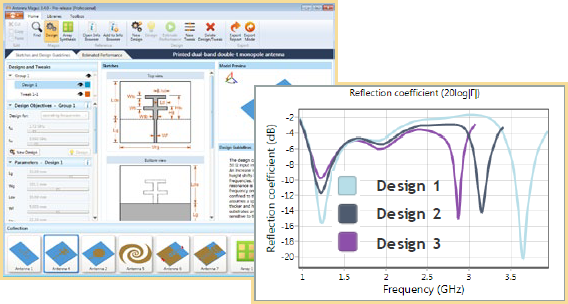Antenna Magus Crack

What makes Antenna Magus different to other antenna design software? Antenna Magus is actually nothing like any other antenna design software product. It takes on a completely new approach to designing antennas. You may have seen other 'Antenna design software' tools that are intended to assist engineers with antenna design but aren't really that useful. This is due to the fact that many of them consist of a very small selection of known antennas that can only be designed for a limited set of objectives over a small range of input parameters.
Antenna Magus: the leading antenna design tool. With a huge database of over 300 antennas, Antenna Magus is the most extensive antenna synthesis tool available today. Posts about Antenna Magus Pro v5.3 Full Crack written.
Another common misconception is that analysis software and antenna design software are the same thing. 'Design' and 'analysis' are in fact two completely different concepts which should not be confused. Analysis forms an important part of the antenna design process, but the design process consists of a number of steps to be completed before the antenna analysis and optimisation can start. An Antenna Magus design case study: Case study 1: 11 GHz Reflector antenna feed with dual polarisation All antenna engineers are familiar with a number of antennas. For some it is only a handful while others seem to have unlimited knowledge of different antenna types and an in depth understanding of the underlying physics that makes them work. Realistically no single person can know everything about antennas, but it does seem that hands-on experience is probably the most valuable commodity in the field of antenna design. When faced with new design requirements, most engineers will start with antenna topologies that they are familiar with. M4 Army Combat Uniform Addons.
Antenna Magus has revolutionised this first step in the antenna design process by broadening the scope of possible antennas that would be considered during the initial phase of design. Let's look at a typical case where an antenna engineer or consultant needs to design an antenna for a specific system or application. Assume the client supplied the following specifications: • Design a feed for a reflector with F/D of 0. Thermal Desktop Software. 6 • Dish diameter: 400mm • Frequency: 11 GHz • Total gain: 25 dBi • Feed antenna -10 dB beamwidth: 80 degrees • Dual linear polarisation The most common workflow would start by setting up a Specification with everything that can be specified, and selecting appropriate suggested keywords, or adding them directly from the keyword dictionary. For this example, the engineer may enter 'reflector feed' and 'dual polarisation capable'. The selection of potentially suitable antennas returned using this Specification in Find Mode is shown below (note that only specifications relevant to the feed antenna have been specified): Reflector feed antenna options. Without any detailed understanding of any of these antennas, the engineer can use the Quick Summary Table in Find Mode, or the complete Information Document in the Information Browser to gain a very good overview of each antenna.
These Information Documents outline basic specifications and highlight advantages and disadvantages of the antennas that might be worth considering for the design. The three antennas that will be investigated for this design are shown below. Three potential reflector feed antennas that will be investigated in this case study Information on these antennas can be compared using the Antenna Magus 'compare' option in the information browser. A 'side-by-side' view in which information is arranged and displayed as shown below: Side-by-side comparison of three antennas' information documents supplied by Antenna Magus.
Click on image to enlarge. Next the engineer adds each of these antennas to the collection, which triggers an automated 'Reference Design' using the relevant objective values from the specification. Since not all the required values have been included in the specification, further designs are added to each antenna in order to try and achieve the required -10 dB beamwidth of 80 degrees. Axial-choke conical horn antenna design. Preview taken from Antenna Magus software.
Diagonal horn antenna design. Preview taken from Antenna Magus software.
Corrugated conical horn antenna design. Preview taken from Antenna Magus software. Note that in most cases Antenna Magus allows the user to design antennas for different objectives like gain, beamwidth and frequency. The corrugated horn can also be designed for 10 dB beamwidth which was specifically implemented for reflector feed design. Eltron P520c Drivers there. The Axial-choke antenna can also be designed for 'main beam flatness' which is often a requirement for reflector feed design as a flat main beam with a steep drop-off illuminates the dish uniformly with very little spill over.